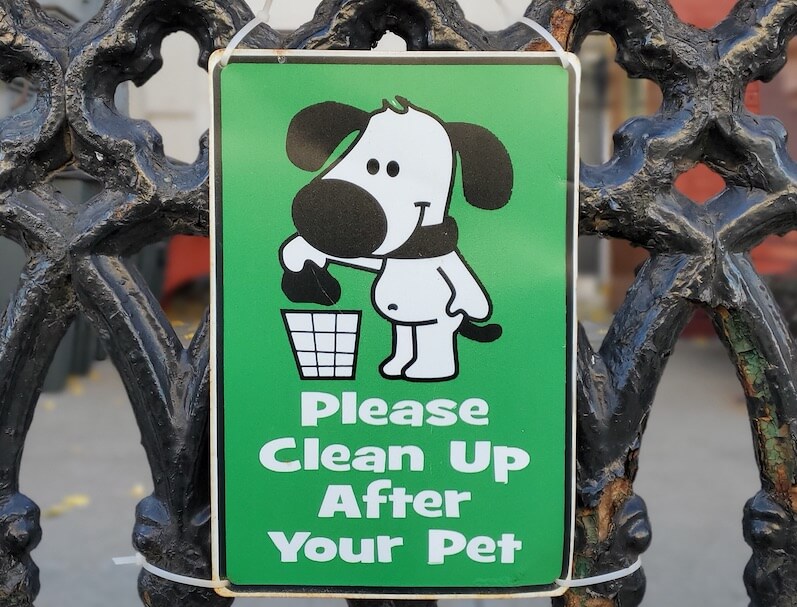Gross but true: Your dog’s poop can provide one of the first warning signs of health issues. And while we’re not normally ones to talk shit, when it comes to helping you keep your dog healthy… we’ll do just about anything.
We reached out to our favorite vet, Dr. Stephanie Liff, to get an expert-overview of how you should handle things when your dog’s stool seems funky, suspicious, or otherwise out of the ordinary.
Like with any family member, you should keep an eye on whatever symptom’s your dog is exhibiting. If you’re worried, don’t just turn to the internet—contact your vet! You should always rely on the advice of your dog’s medical provider if you have concerns or think they may have eaten toxic foods. (And speaking of vet visits… have you gotten your furry friends pet health insurance for dogs yet?)
Here’s what we learned when we asked Dr. Liff to school us in the finer points of canine defecation. Take notes, and you too will be a dog poop pro before you know it (#lifegoals, right?).

Decoding the color of your dog’s poop
Like any good pet parent, you’re keeping a close eye on your dog, and part of that means having an eye on their pooping habits. If something’s off, the first thing you might notice is a change in the color of your pup’s poop. Used to chocolate brown and getting more of a cafe au lait?
☻If your dog’s poop is lighter than normal…
This is a sign of maldigestion, which is just a scary way of saying something’s upset their stomach. It could be that your furry family member ate something they shouldn’t have, and it will usually resolve on its own. No need to panic!
☻If your dog’s poop is darker than normal…
This could be because of a change in your dog’s diet, and is typically not a cause for concern. Unless it’s really dark…
☻If your dog’s poop is black and tar-like…
This could be a sign that there’s blood in your dog’s stool, which could mean a serious gallbladder-related issue.
This black poop is called melena and it can be a sign of intestinal bleeding… or it could just be that they ate something black. Either way, you’re going to want to contact your vet right away.
☻If your dog’s poop looks like raspberry jam…
This is a signal that your dog could be suffering from colitis, pancreatitis, or hemorrhagic gastroenteritis.
Dog owners who overdo it with meat and bones for their pups are most likely to encounter this. If so, it’s time to talk to your vet about your pet’s diet. When a dog’s large intestine is inflamed their stool reflects it with excess water, blood, and mucus. If you’re seeing this, or bright red blood, you should let your vet know immediately.
☻If your dog’s poop is white, it’s called acholic feces.
It usually means your dog is suffering from an exocrine pancreatic insufficiency, which basically means their pancreas isn’t producing enough digestive enzymes.
☻If your dog’s poop is orange or yellow…
It could be a sign of an issue with their liver, or biliary disease. This might mean that your pup’s liver isn’t outputting enough bile their feces will move through the GI tract without collecting the stuff that gives it the normal chocolate brown color you might be used to. But don’t leap to conclusions here—it could just be an upset stomach.
We know what you’re thinking: ‘I wish there was a dog poop chart I could print out and tack to my bulletin board!’
You’re in luck. Here’s a cheatsheet to what the color of your dog’s poop means. Before you pick up the phone, keep in mind that Dr. Liff says it’s generally okay to wait until the second time you see an unusual poo before reaching out to your vet.
| Color of poop | What it means | Call the vet?* |
|---|---|---|
| Chocolate brown | That’s a healthy dog! | No |
| Lighter brown | Your dog has an upset stomach. | No |
| Darker brown | Your dog may have eaten something without you knowing. | No (unless it’s black) |
| Black | This is a sign of blood in your dog’s stool, and it could be a gallbladder issue. | Yes |
| Red | Could be colitis or hemorrhagic gastroenteritis. | Yes |
| White | Could be acholic feces. | No |
| Orange or Yellow | Could be a sign of biliary disease, or that poop is moving too quickly through the GI tract. | Yes |
| Rice-like grains | Could be a sign of tapeworms. | Yes |
Decoding the shape of your dog’s poop
Yup, the actual shape of your puppy’s poo can help you hints about your dog’s health.
☻If your dog’s poop is solid and well-formed…
You’re in the clear. That’s what healthy dog poop looks like.
☻If your dog’s poop is shaped like a ribbon…
It’s usually a sign that something’s compressing their colon. That could mean swollen lymph nodes, an enlarged prostate, or other factors that cause your pet’s waste to come out skinnier than usual. Tell your vet!
☻If your dog’s poop comes out in a bunch of small pieces, or like little pebbles…
It usually means they’re constipated. If you’ve recently switched your puppy to a new food, you may want to reconsider… your dog’s diet has a big impact on their overall health, and bowel movements are just a small part of that.
☻If your dog’s poop is softer than usual…
It could be a sign of an intestinal issue. What do we mean by “soft”? Loose stool is hard to pick up with a plastic bag… check with your vet to be on the safe side that there’s no bigger gastrointestinal issue at play.
☻If your dog’s poop is watery, formless, or coming out like soft-serve ice cream…
It’s considered to be diarrhea. (We’re sorry if we just ruined ice cream for you.) It’s important to pay attention to the consistency, because these specific details can help identify what’s causing your pooch to be sick.
Here’s a cheatsheet to what the shape of your dog’s poop means, and remember… Dr. Liff says you only need to call the vet if you see these occur more than once.
| Shape of poop | What it means | Call the vet?* |
|---|---|---|
| Solid | That’s a healthy dog! | No |
| Ribbon-like | Something is pushing down on your dog’s colon. | Yes |
| Pebble-like | Your dog is constipated. | No |
| Softer than usual | An intestinal issue. | Yes |
| Watery or formless | An issue with the large intestine. | Yes |
| Soft-serve style | Small intestinal dysfunction. | Yes |
Decoding the frequency of your dog’s poop
The average dog poops at least once a day; anything more than four times a day could be considered excessive. But what happens when you notice a change in your dog’s typical frequency?

☻If your dog is pooping more often than usual…
It could mean there’s a large intestinal issue. There’s a chance your pooch has colitis, especially if they’re having diarrhea. This is a good reason to call your vet.
☻If your dog is pooping less often than usual…
It could just be the result of constipation. It could also be intestinal maldigestion issues reflecting some irritation in your pup’s digestive tract.
☻Your dog could also be pooping less because they’re eating less…
This is always a reason to check in with your vet. The solution could be as simple as adding probiotics to your dog’s food!
Decoding the smell of your dog’s poop
We’ve tried to keep the yuck in this article to a minimum, but there’s no way to dress up the smell of dog poop… so here we go.
☻Your dog’s poop probably always smells, but if it’s really foul…
This can be a sign that your dog has a worm infection. Tapeworms and roundworms can take your dog’s stink to the next level, so if something smells extra bad it’s worth getting checked out.
☻If your dog’s poop has a new metallic scent…
It could be a sign that there’s blood in their stool. This is always a reason for pet owners to visit the vet.
You made it! Now wash your hands
That was some tough crap—but we reached the end!

Now that we’ve reviewed the main things you can learn about your dog’s health from their poop, it’s time to move from stool samples to something a little more fun.
Give your pup a belly rub from us, then check out this article on the best pet cameos in music videos… and don’t forget to get your furry friend hooked up with Lemonade’s pet health insurance!




